Pst! Don’t tell the Architect…
This week: Dismantling the store; Pst! Don’t tell the Architect…; In the workshop; COVID-19; Garden Matters;
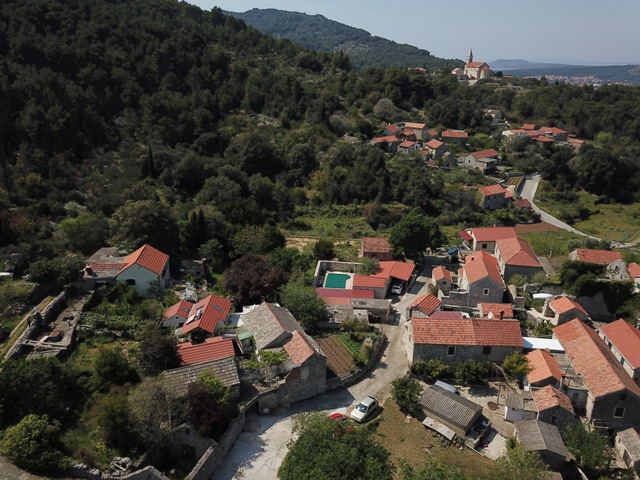
Another week has zipped passed!
We are into May now, Svibanj in Croatian, meaning the month of budding trees. Although there are few trees not in full leaf on Hvar.
I have two Bougainvillea that are still bare. One I bought new from a nursery in Split last autumn, the other is old.
When I scrape a finger nail against the bark, both are green underneath, so I am hopeful they are just a little late this year.
I have almost filled my Springwatch calendar. There are just a couple more entries, usually due in mid to late May, but all the rest of the entries against the indicator species are complete.
I need to sit down and work out how to write a formulae to average the dates between different years in a spreadsheet, but that can wait until a rainy day.
My quick analysis is that two thirds of the indicator species are earlier than last year by more than a week. However I should issue a “health warning” about my figures.
Firstly I’m not a qualified statistician, and secondly I’ve not been collecting data long enough to really do an analysis.
Dismantling the store
My temporary store has been dismantled this week.
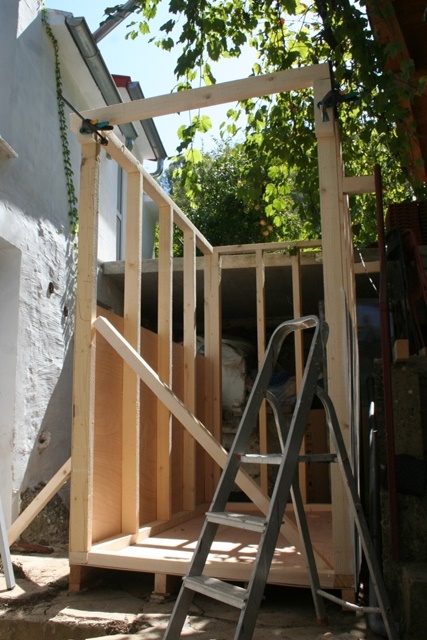
I built it last summer to enable me to move things like windows, radiators and insulation into one single space. But as I mentioned last week, I needed to remove it so the alignment of the steps can be changed.
Generally when I build something, it is over engineered and built to last. In the case of this shed, it was a half and half build.
The framing was built to stand the test of time, but the actual construction was intended as something that could be easily dismantled and then re-assembled, if needed, somewhere else.
I used stainless steel SPAX T20 screws throughout, which meant that with an electric screwdriver, it was simple to undo the various length screws.
They have all been saved in a single tub, so if and when I decided to rebuild it, everything I need will be in one place.
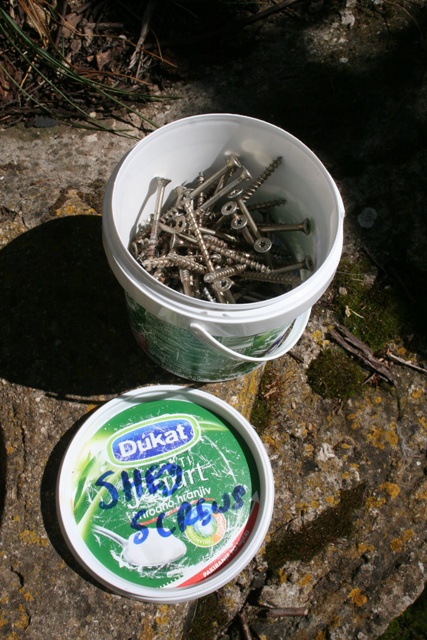
The most difficult part of the dismantling process was the waterproof joints. I had used an external silicone frame sealant and in a couple of places waterproof wood glue.
These joints were by far the most difficult to prize apart. But come apart they did, without too much trouble.
Once dismantled, everything is now under cover, waiting for it’s next incarnation…
Don’t tell the architect…
I am a planner. Whether it is a disaster planner for emergencies like COVID-19, a garden design planner, or something simple like a shelving frame.
On one of my book shelves where all the files relating to my Dol house reside, there is a folder simply called “Plans”. It does what it says on the box.
I’m no Michelangelo, but I can produce a reasonable 3D technical drawing of something. I generally work in pencil, with coloured felt tips for detail and clarity.
So on Tuesday when Cvjetko was thinking about how to change the orientation of the steps which lead from the courtyard to the patio and first floor of the buildings, we started to plan.
I still have a box of yellow wax chalk sticks. These were used in crash investigation in the days before the GPS theodolites and mathematical crash reconstruction techniques in use today.
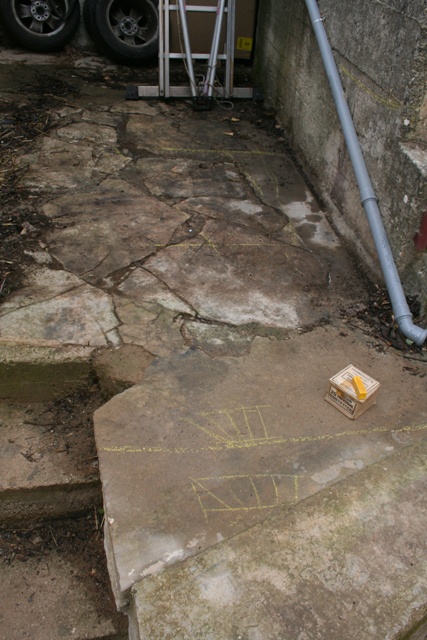
You drew around a vehicle with the chalk and drew an accurate plan which was always called a “sketch plan”. It was clearly marked “no to scale”, even if it was!
This was so later at court the defence couldn’t quibble over the odd half inch. Then once the vehicles were removed, you searched for marks, debris and confirmed a causation.
There is an apocryphal story from the 70’s or 80’s, that a crash involving three cars at one of the junctions in Kingston upon Hull was immortalised because a little later the road repairers came along.
Following standard practice they dug out between the yellow chalk corners and resurfaced the blocks following the shape of the cars.
This was the time before spray-on road paint and the man who identified defective road surfaces, also used yellow wax chalk!
Cvjetko started to draw some idea on the concrete steps with a graphite pencil, but it wasn’t very good, so I produced the box of chalks.
There are now lots of lines, some crossed out and some interesting shapes to try and solve the problem.

The problem is that from the courtyard floor to the patio is a vertical height of 1.92 meters or 11 standard steps, but there is insufficient distance to have a straight flight of steps, so we are going to have to innovate.
In the photograph, the line below which there is some greenery is the old level of the sloping courtyard.
Having employed an architect, who has produces pages and pages of detailed drawings, using AUTOCAD, don’t tell him that we are doing our own planning with wax crayons on concrete.
He’d have a dickey fit!
In the workshop
I’ve asked this question before, “How do you eat an elephant?”
The answer is simple, one bite at a time…
That is how I feel about the inside of the workshop. Cvjetko keeps asking whay I have not got it finished yet?
Well…. because I keep doing other jobs – like planning steps – so his work is not held up.
There is also the issue of the amount of work to be done. Everything needs two coats of paint, and in the case of the doors and wooden windows, three coats of paint, and the new concrete has to be treated first with sealant….
I keep doing a bit of painting. Just the walls where the Integrated Thermal Store (ITS) will go took the best part of a morning. OK, we did stop for coffee for a half hour.
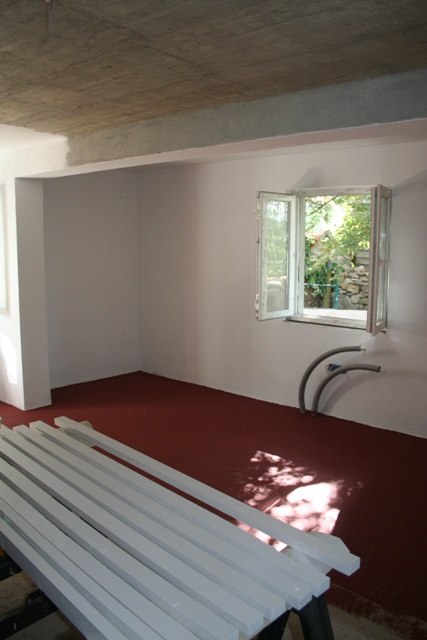
It takes a lot less effort to paint the floor than to paint the ceiling and things need to be done in sequence.
The third of the workshop where the ITS will go is now finished and I have started on the wooden shelving supports that I’ve now fixed to the wall. Something else which will need a couple of coats of paint.
To be able to empty the temporary store, so we could access the area where the new steps will go meant that I had to make room for the radiators and other building materials. So I moved in my wall mounted rack system for nuts, bolts, screws and washers.

I also have a couple of very old pine chests of drawers which is where I keep all my wood saws, hammers and hatchets, grinders and cuttings tools together with other bits and bobs.
When I was doing some work this week it was lovely to be able to easily access the screws and washers I needed, together with space to work. And this is before most of my tools and equipment have been moved into the new workshop.
Next job is building the main doors.
COVID-19
I’ve been shopping this week, the first time for over five weeks. The country and island has been in lockdown since mid March.
I last went shopping on the 17th March but by then I had already created a six weeks supply of staple foods.
The arrival of Gizmo’s girlfriend at mealtimes meant that the cat food hasn’t lasted quite as long as expected.

However this week the government has allowed a slight easing of restrictions.
There are currently 2,085 officially confirmed COVID-19 cases in Croatia. 1,421 patients have recovered.
Sadly seventy-five people have died and there are currently 17 patients on ventilators. There are 659 active cases undergoing treatment.

Here on the island ferry travel remains suspended. The three cases of COVID-19 here have all recovered. They were identified early through testing, were quickly quarantined, contact tracing was efficiently carried out and there was no spread of the virus.
Whilst one or two islanders have complained about being prevented from travelling to Split, as the city has the second highest total of cases in the country and the greatest number of recorded deaths, I think the restriction is a sensible and needed precaution.
I chose my shopping time carefully – early afternoon when there are the fewest people about. I had my gloves, face mask and hand sanitiser in the car and used them.
The police checkpoints were gone and there were very few vehicles on the road. Tommy, the largest supermarket on the island was almost deserted.
There are still restrictions on the number of people allowed into the supermarkets, but it has been increased from 5 to 15. I think there were more staff than customers when I was there.
All the shelves were full and I was able to get everything I needed. I did a four week shop, so I can retreat back into limited isolation to see what happens next.
The island exists for tourism, with wine as its only export. Olive oil is generally for domestic consumption with no commercial cultivation of olives.
There were fewer people in Stari Grad than on a cold January afternoon when the bitter Bura wind is blowing in from the north.
But the sun was shining, the harbour was tranquil with only the slightest movement of wind across the water and the temperature was just right.
Like all countries, Croatia is trying to work out how to lift the lockdown restrictions without creating a second wave of infections. The borders and airports are still closed along with schools, cafes, bars and restaurants.
These are three images showing the number of aircraft flying in Europe, before the lockdowns started on the 16th March.

In the middle of the lockdowns on the 4th April.

Finally this afternoon, the 2nd May. Checking on the flights, almost all of them are airfreight or cargo aircraft.

Garden matters
“I see no ships” is a popular miss-quote of the British Admiral, Horatio Nelson. The real quotation is “I really do not see the signal.”
The year was 1801 and Nelson was leading an attack on the city of Copenhagen.
After three and a half hours of punishing attack and counter attack, the British Admiral, Sir Hyde Parker used flags to signal a withdrawal.
Nelson’s attention was drawn to the signal, but raising his telescope to his blind eye he uttered his now famous words.
The phrase “turning a blind eye” to something had entered the lexicon of English language.
Several times this week I have stopped doing a job in the workshop and wandered into the weeds, sorry, I mean the orchards…
With a little rain and lots of sunshine, everything is growing. I decapitated a few of the larger specimens that were in flower and were about to set seed, but other than that I have done little.
In the drupe orchard, where I planted the Lucerne, it is doing a great job of keeping weeds at bay. It is almost ready for its first cut.

In the next row, I have a serious crop of grass growing.
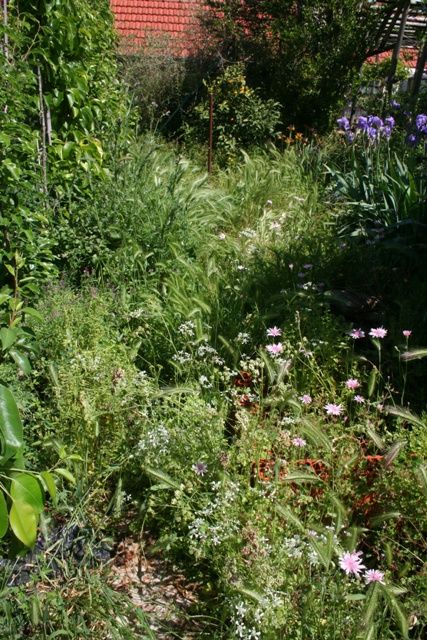
This next week I will really have to do something or I will be overrun with weeds. For now I’ll just a turn a blind eye to everything…
On Tuesday my neighbours shouted across the donkey track that they were having problems with aphids.
So I mixed some hand soap and water in the sprayer and liberally coated the peach and nectarine saplings. These are especially susceptible to attack by aphids.
Soapy water is an environmentally friendly way of preventing and dealing with the pests, in the absence of large numbers of their natural predators, the Ladybird.
I do have some Peach Leaf Curl, which is caused by a fungal infection The RHS say that wet condition in the spring are the catalyst for the fungus to appear.
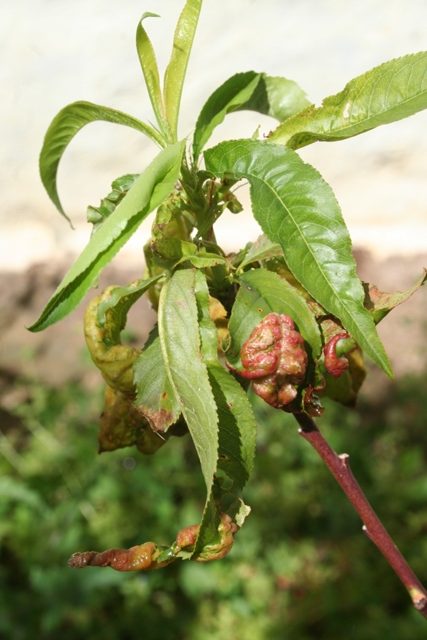
Well wet is the one thing we have not had this year, but I still have the distorted leaves. I need to remove them before the spores spread, so starting the infection cycle again.
My Callistemon is in flower at the moment.
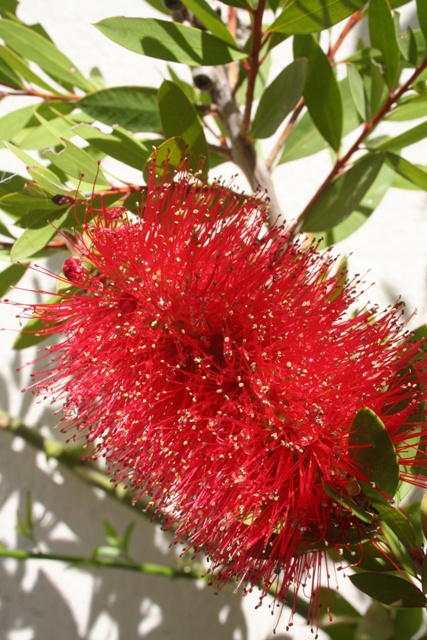
Although an Australian native, it actually likes moist soil conditions, so I keep it in a large pot where I can control its growing conditions and keep it in flower until October.
The Honesty plants also now have their seed pods showing.

They will grow to be four centimetres across then dry and turn translucent by the autumn.
This year there is a bumper crop of Borage. it is a feeding flower for a lot of insects, the sky blue flowers shimmering in the sunshine. NRC
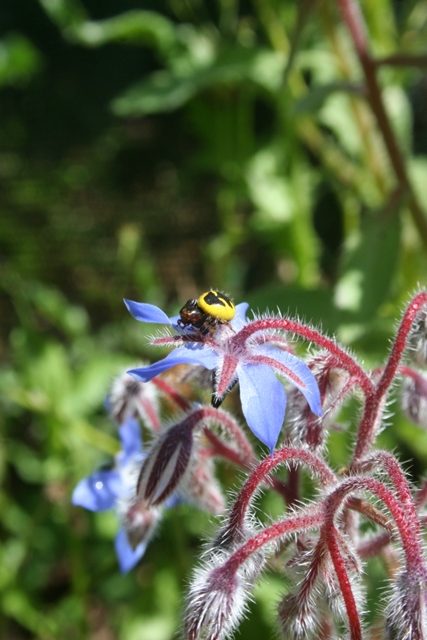
4 Responses
Richard Ellis
Planning on an enlarged family with kittens?
Glad to hear that you have things in hand, or as well as expected.
Enjoy the progress reports and location photos.
Tony Griggs
Nice to see you have an Aussie plant amongst yr garden Norman! Looks like you are taking slow steps forward but yr garden is keeping you busy! We’ve had an extraordinary amount of rain here in southern Victoria. The local (Tarwin) River has broken its banks. I haven’t seen that happen since I was a teenager! ( a while back!). We are also in lockdown but fortunately the cases are few. Our economy is going to take a king hit though! Linda is safety ensconced on Flinders Island learning to play her new piano! Stay well
Elizabeth
Peach leaf curl is a pain… once it shows up it seems to stay about. The advice that I found was that one needs to clear up all leaves in autumn. In my experience, a good healthy plant/tree is probably more likely to be able to defend itself. Maybe some potash around the tree might help? I assume you will have a fair amount of that from your wood burner. I have been giving one of our old roses a regular dose of wood ash from our wood burner and it seems to be helping it fend off black spot. I know that the RHS don’t say anything about that as a solution but it might be worth a try. Anything that strengthens the health of the plant will help it defend itself. My rose (30+yrs old) seems to be doing really well on it – though now the kitchen extension is there the microclimate has changed, which might also help. Difficult to tell.
AutoCad is great but the realities of what is happening on the ground sometimes results in the need for tweaks! It allows you to get there or thereabouts though! Loved the yellow car markings on the road story.
Gizmo has found himself a pretty girlfriend! Your family seems to be growing.
All well here – village plans coming together for a socially isolated VE75 celebration! Unfortunately no church bells – decree from beyond the vicar. Lovely cotton bunting has arrived – will serve for many years to come!
Marcy Fletchall
Your flowers are so beautiful and the house, etc. is really coming along. Wondering what is on your “to do” list after all is built, painted, and done? Glad you are ok. Best, Marcy